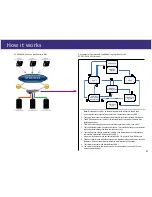
Advanced Features
Advanced Features
NAT
– NAT (Network Address Translation) is the technology which allows a number of LAN PCs to share one (1) Internet IP address.
Remote Access Configuration
– This feature allows you to manage the XC-DPG603 via the Internet. You can restrict access to a specified IP address or address range.
External Filters Configuration
– These settings determine whether or not the XC-DPG603 should respond to ICMP (ping) requests received from the WAN port.
Interface Binding
– Use these to ensure that certain traffic is sent by a particular WAN port, and thereby a particular ISP account. These settings are only useful if using both WAN ports.
Protocol & Port Binding
– This allows you binding WAN 1 or WAN 2 ports by selecting TCP/UDP protocol
Settings - Advanced Features
NAT Configuration
•
NAT Routing
– NAT (Network Address Translation) is the technology which allows one (1) WAN (Internet) IP address to be used by many LAN users.
- If you disable NAT, Internet access is only possible if all PCs are configured with valid Internet IP addresses. (The XC-DPG603 needs 2 addresses: 1 for the LAN port and 1 for the WAN port.)
- NAT is disabled only when you wish to use the XC-DPG603 as a Static Router.
•
TCP Timeout
– Enter the desired value to use on both WAN ports. The default is 300.
•
UDP Timeout
– Enter the desired value to use on both WAN ports. The default is 120.
•
TCP Window Limit
– Enter the desired value to use on both WAN ports. The default is 0 (no limit).
•
TCP MSS Limit
– Enter the required MSS (Maximum Segment Size) to use on both WAN ports. The default is 0 (no limit).
•
Disable Port Translation
– Enter the desired port range of all packets which are not translated via WAN port.
Remote Access Configuration
•
Remote Upgrade
– If enabled, you can u�
•
Remote Web-based setup
– If enabled, access to the Web-based interface is available via the Internet. If not enabled, access is only available to PCs on the LAN.
•
Port
– The port number used when connecting remotely. See below for details.
•
Allowed IP range
– Remote access is only available to the IP addresses entered here.
- Leaving these fields blank will allow access by all PCs.
- These addresses must be Internet IP addresses and not addresses on the local LAN.
- To specify a single address, enter it in both fields.
External Filters Configuration
These settings determine whether or not the XC-DPG603 should respond to ICMP (ping) requests received from the WAN port.
•
Block Selected packet types
– This acts as “master” switch. If checked, the selected packet types are blocked. Otherwise, they are accepted.
•
Echo Request, Timestamp Request
– Select the packet types you wish to block, using the checkboxes.
Dynamic Routing
•
RIP v2
– This acts as “master” switch. If enabled, the selected WAN or LAN will run RIPv1/v2.
•
LAN, WAN1, WAN2
– When enabled, any WAN or LAN can execute RIP function.
DNS Loopback
Some servers on a LAN and their domain names have already registered on public DNS. To avoid DNS loopback problem, enter the following fields.
•
Domain Name
– Enter the domain name specified by you for local host/server.
•
Private IP
– Enter the private IP address of your local host/server.
Interface Binding
SMTP (Simple Mail Transport Protocol) Binding
(This applies only when using E-mail accounts from different ISPs on each port)
Some ISPs configure their E-mail Servers so they will not accept E-mail from IP addresses not allocated by themselves. If you are using accounts from different ISPs, sending E-mail over the wrong
port may result in non-acceptance of the mail. In this case, you can use these settings to correct the problem.
•
Enable
- When enabled, the port you specify below will be used for all outgoing SMTP traffic. If not enabled, either port will be used.
•
WAN 1 / WAN 2
– Select the desired port.
Protocol & Port Binding
Use these settings if you wish to ensure user-defined traffic to be sent by a specific WAN port. This allows that user-defined traffic to be handled by a designated ISP account.
•
Enable
- Enable or disable each item as required.
•
Source IP
- IP address of source which packets are sent from.
•
Destination IP
– IP address of destination which packets are sent to.
•
Subnet Mask
– With subnet mask other than 255.255.255.255, you can make a IP sub-network as your destination.
•
Protocol
- Select the protocol used by the traffic you wish to configure.
•
Port Range
- Enter the beginning and end of the port range used by the traffic you wish to configure. If only a single port is used, enter the port number in both fields.
•
WAN
- Select the port you wish this traffic to use.
28
















































